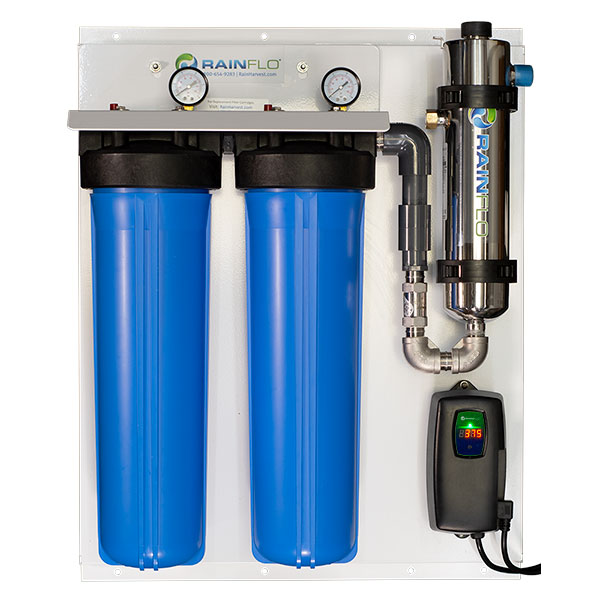Many rainwater harvesting systems used for drinking water off-grid and collected by a roof rely on a combination of sediment filters, carbon filters, and ultraviolet (UV) light to remove all unhealthy impurities and ensure the water is potable and safe to drink. How do you filter rainwater from a roof?
Best filtration treating potable rainwater:
- Leaf Guard Filters-catch most leaves & twigs
- Downspout filters-catch large particulate
- Sediment Filter size measured in microns 25-micron-5-micron filters
- Activated carbon kills bacteria 1-5 microns
- UV Sterilization kills bacteria still present in H2O
- RO
- Chlorine
Typically there are two ways of harvesting rainwater, Surface runoff harvesting and Rooftop rainwater harvesting. Rainwater harvesting is the collection and storage of rain for reuse normally on-site, rather than allowing it to run off.
How to Filter Rainwater From a Roof
Despite rainwater being essentially distilled by the sun, gases in the atmosphere contaminate the water while it falls to the earth making the rainwater undesirable. Water collects dust, smoke, and air particles when it falls to your rooftop, where it can collect contaminants such as lead, copper, asbestos, sediment, dirt, bacteria, viruses, and more.
Before this water can be used as potable water, it must be purified of these impurities. The best filtration options for making rainwater potable are mechanical filtration is also integral to the complete success of rainwater treatment.
A rainwater collection system can catch most large particulate matter as it collects on the roof, such as leaves and twigs. The most common debris found in stored rainwater is fine grains of sand and dirt. While filtration systems should be equipped to remove this particulate, you do not want to overload it. The proper way is to remove it from larger to smaller.
Most systems are designed to eliminate very small sediment and debris. Starting standard string wound or spun polypropylene sediment filters are cheap and highly effective and prolong the life of your more expensive Carbon or even RO filter systems. The filtering system works much like any type of filtering system where larger items are removed first down to the smallest ending with microbes at the end.
- Downspout debris filters and leaf guard filters are the best filters to install in your rainwater harvesting system, to filter the water as it travels from the roof down the drainpipe to the storage container. These filters trap large debris like leaves, rocks, and other materials that could be blown or washed into the gutters from the rooftop.
 The most effective way of keeping rainwater clean is to prevent dirt and debris from entering the storage tank in the first place. To do this, most systems use a pre- or in-tank filter.
The most effective way of keeping rainwater clean is to prevent dirt and debris from entering the storage tank in the first place. To do this, most systems use a pre- or in-tank filter.
These generally consist of a stainless steel element housed within a plastic body, though some inferior models are entirely plastic. The element is usually a stainless mesh or grill. The fineness of the mesh is measured in microns – the lower the micron the more efficient.
While rainwater is filtered naturally through solar distillation (A solar still distills water with substances dissolved in it by using the heat of the Sun to evaporate water so that it may be cooled and collected, thereby purifying it)
They are used in isolated places where drinking water is unavailable so that clean water is obtained from dirty H2O or from plants by exposing them to sunlight.
Still, types include large-scale concentrated solar stills and condensation traps some not-so-fresh things happen to the rain on the way back down.
Once the rain hits the roofs it will collect all the organic material (animal feces and all) that collects there. To return the rain to a potable state once again, there are some time-tested, successful methods to use for filtration:
- Sediment Filters-Moreover, by reducing the sedimentation on your incoming water supply, your in-home sediment filters will last longer, saving you money! Sediment filters are used to

Pre-Sediment Filters before UV Sleeve remove the fine sediment, improving color, taste, and odor that may remain in your rainwater after pre-filtration.
Sediment filtration is typically used in conjunction with UV disinfection to disinfect rainwater for indoor uses. If you are looking for replacement cartridges for sediment filters. Sediment size is measured in microns, the higher the micron reading, the larger the particulate.
- Activated carbon: All rainwater will carry with it its own taste and odor, and rainwater is no exception. To get the best water quality possible, as well as the best-tasting water, a granulated activated carbon filter is a must for any rainwater harvesting system. As a homeowner, you would have the option of going with a simple GAC cartridge filter, or a more thorough and larger household GAC unit.
A 5-micron activated carbon filter could be used right before a UV sterilizer. Activated carbon filters have been used to treat the odor and taste problems in water for a long time. Today, they are used in millions of residential and commercial-grade systems. Activated carbon has been proven to be an excellent method of producing better-tasting water as well as removing harmful water contaminants.
- UV Sterilization: The final step in any rainwater filtration system needs to be disinfection (killing bacteria) or sterilization (sterilizing bacteria so that they cannot reproduce, thereby rendering them harmless). Even after filtering the water down to 5 microns, bacteria can still be present in the water.
Alternative Rainwater treatments use RO (Reverse Osmosis) and Chlorine for disinfection. While many rainwater systems also use chlorine to disinfect the water, the preferred method for bacteria filtration is ultra-violet sterilization. In many Rainwater Harvesting systems, the series of treatments is Downspout Fiters-Sediment Filters-Activated Carbon-UV Sterilization treatment
JimGalloway Author /Editor


